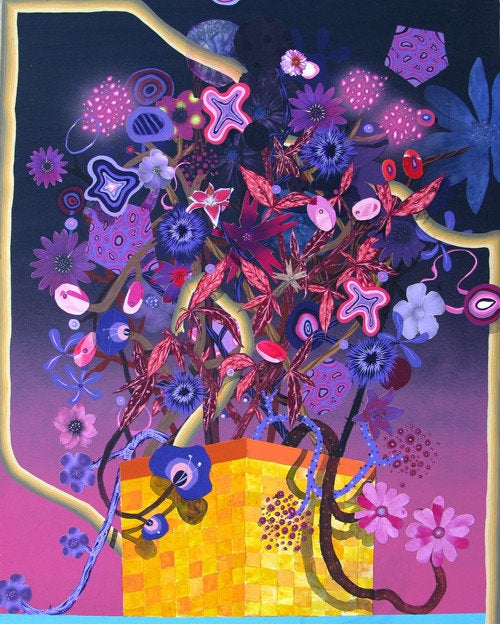
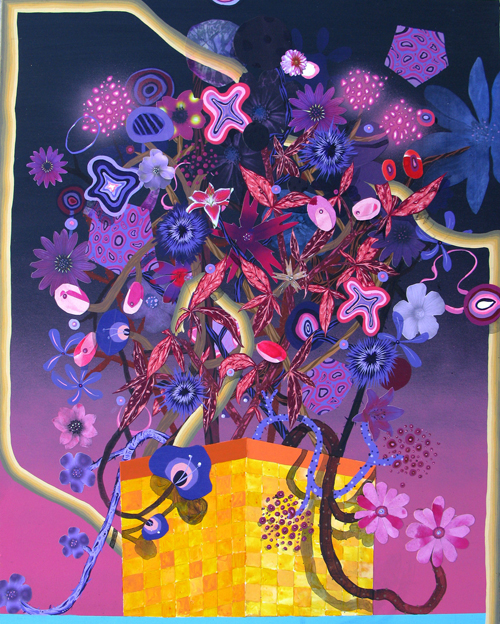
"The First Sunrise," 2012, acrylic, watercolor, ink, collage, colored pencil on paper mounted to canvas, 24 by 30 inches, courtesy of Gallery Wendi Norris
Amir Fallah is best known as the publisher of the print book Beautiful/Decay and the website of the same name. Fallah is also a painter who received his MFA in painting at UCLA and has shown his work for over a decade in solo shows in Los Angeles, San Francisco and Dubai.
I visited Fallah in his L.A. studio where we talked about the over-saturation of the Andy Warhol influence and the beauty of Robbie Conal's work, among many other things. While Fallah is obviously hip to a huge variety of artists and their work, it's his own work that drives his passion for art.
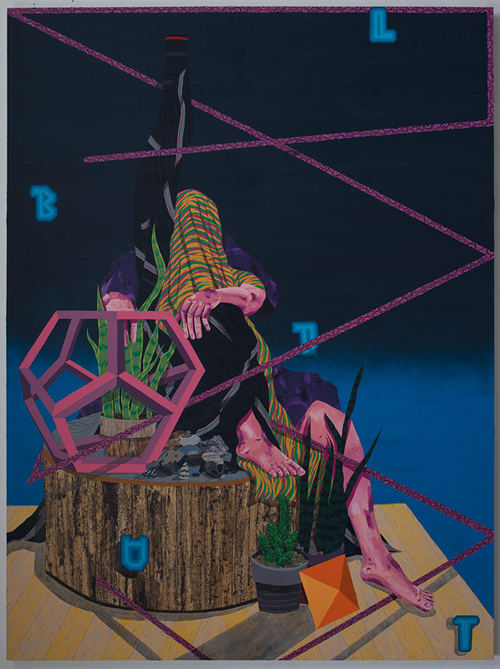
"Explosions That Are Built To Spill," 2012, acrylic, oil, ink, pencil and collage on paper mounted to canvas, 96 by 72 inches, courtesy of Gallery Wendi Norris
TH: Obviously your work is influenced by surrealism, and you've said that you like to deny bits of reality in your work by doing things like making objects defy gravity or create shadows that do not exist. Where does this need to mess with reality come from? What are you trying to get your viewer to experience?
AF: I do think that my work has a surrealist bent to it, but I'm not sure if I would consider myself directly influenced by surrealism. What comes across as surreal are areas in the paintings where I try to create a sense of tension by bringing moments of abstraction into an otherwise representational image. This is done a few different ways, sometimes with shadows, a change in material or paint handling or with the introduction of patterns, borders, typography or ornamentation that weave in and out of the image disrupting the reality of the image. This disruption of the image is extremely important for me, as it keeps the painting on its toes, so to speak, and adds a level of visual uneasiness that keeps it from being overtly decorative.
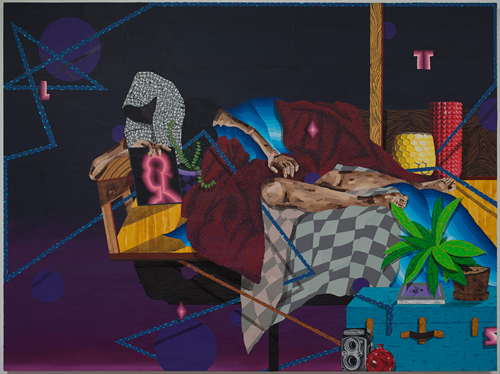
"She Who Loots The Persian Empire," 2012, acrylic, oil, ink, pencil and collage on paper mounted to canvas, 96 by 72 inches, courtesy of Gallery Wendi Norris
TH: When we spoke earlier, you said you like to create psychological spaces in the way Francis Bacon does. What kind of spaces are you trying to convey? How do they reflect our society? Do you think they spaces are influenced locally or globally?
AF: I've always been attracted to the non-descript spaces that are in Bacon's paintings. You can tell that the figures are in a room, but nothing specific can be derived from the space. My paintings function in the same way in that I'm not concerned with placing the figure in a specific setting. The images are based on photographs, but once they are transferred onto the canvas they become three-dimensional objects in space. Although the paintings are technically figurative, I see the figures as another sculptural element mixed in with the everyday objects that we all surround ourselves with.

"The Last Sunset," 2012, acrylic, watercolor, ink, collage, colored pencil on paper mounted to canvas, 24 by 30 inches, canvas 7 by 5, courtesy of Gallery Wendi Norris
TH: You are more recognized for your work as founder of Beautiful/Decay, than your painting practice. I can imagine what it is like to balance both of those things; they are similar yet very different. How does this affect the way you paint? You told me this leads to a lot of painting in the wee hours of the night and morning. How is this alternating of mental states influencing your work in a way that an artist who isn't so involved in the job of talking, writing and curating art on an ongoing basis, might not be?
AF: Being an artist has always been my main priority and focus. It is a challenge to balance the two worlds, but I see Beautiful/Decay as an extension of my studio practice. It's my resource tool and my reference material. These days I only oversee the day-to-day activities of Beautiful/Decay projects, so the workload has gone down significantly, allowing me more studio time. It's obviously a lot to take on and there are some scheduling challenges, but I've managed to strike a good balance between studio time and work. Most artists I know teach or work as studio assistants. I just happen to publish artist books instead.
I also think there is a shift in the artist's role. Some of my favorite shows, books and interviews are those curated, created and conducted by artists. Writers, critics and curators are important, of course, but there is a directness to shows and projects that are organized by artists that museums and institutions can't replicate.
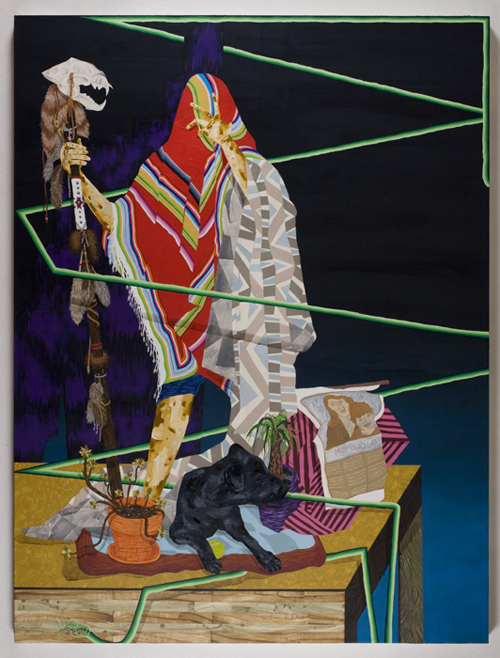
"The Indigenous Hunting Ritual," 2011, acrylic, oil, ink, pencil and collage on paper mounted to canvas, courtesy of Gallery Wendi Norris
TH: Early on, you decided you did not want to be identified as an American-Iranian artist, as we discussed there is too much of an exclamation point associated with hot Middle Eastern topics and artists. Yet you can see the influence of Eastern art, Persian miniatures and more in your work. How have you gone about letting your heritage influence you without boxing you in at the same time?
AF: It's not that I don't want to be identified as an American-Iranian artist, as I'm very proud of both my Iranian and American heritage. Rather, I'm more concerned of the narrow focus that most "Middle Eastern" art has these days. It seems that there is a certain level of preoccupation with work that has an exotic cultural origin. I'd like to have my work stand on its own, regardless of where I was born or grew up. There are certainly references to my heritage in the work, but I try my best to let them work their way into the pieces in a natural way, rather than bombarding the viewer with cliché cultural signifiers from the East just to align myself with a certain region or hot art market.
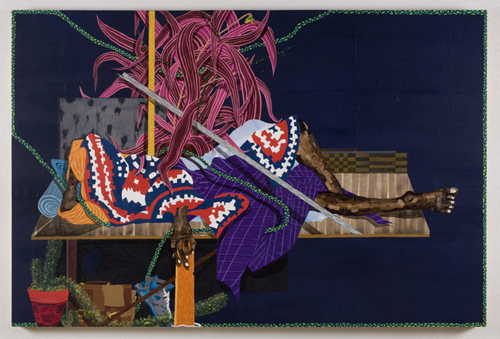
"Training For The Infinite Recline," 2011, acrylic, oil, ink, pencil and collage on paper mounted to panel 6 by 4 feet, courtesy of Gallery Wendi Norris
TH: You have a very interesting concept behind your newest body of work. Why don't you describe your process for our readers?
AF: My process can be broken up into two parts: The first part is research-based and the second part happens in the studio, and is much more intuitive.
I start each piece by going to someone's home, and creating and assembling a collection of personal possessions in the form of a loose still life. As I walk through their home, I discuss the different mementos and trinkets that they surround themselves with. These casual discussions come into play later on in the work when I'm in the studio. The subject is then placed within the still life and quickly photographed, surrounded with the objects that they live with. Blankets are piled on the subject's head, plants are placed by their feet and the mundane materials of life cover the floor.
Once I'm back in the studio, the photo is edited and tweaked. This is the point when the true image-making process starts. The image is drawn, painted and collaged onto the surface of the canvas, keeping true to the photograph at certain points and at others completely denying the original reference image. Colors are changed, and textures are interpreted liberally. The result is a coded portrait of a ghost-like figure whose identity is masked, altered, edited and deconstructed through the painting process.
Fallah's work is part of a group show at the UAM museum called Chockablock opening January 26, 2013. He will be having a solo show at Gallery Wendi Norris which opens March 7, 2013.
You can check out more of Fallah's work at his website at amirhfallah.com.
